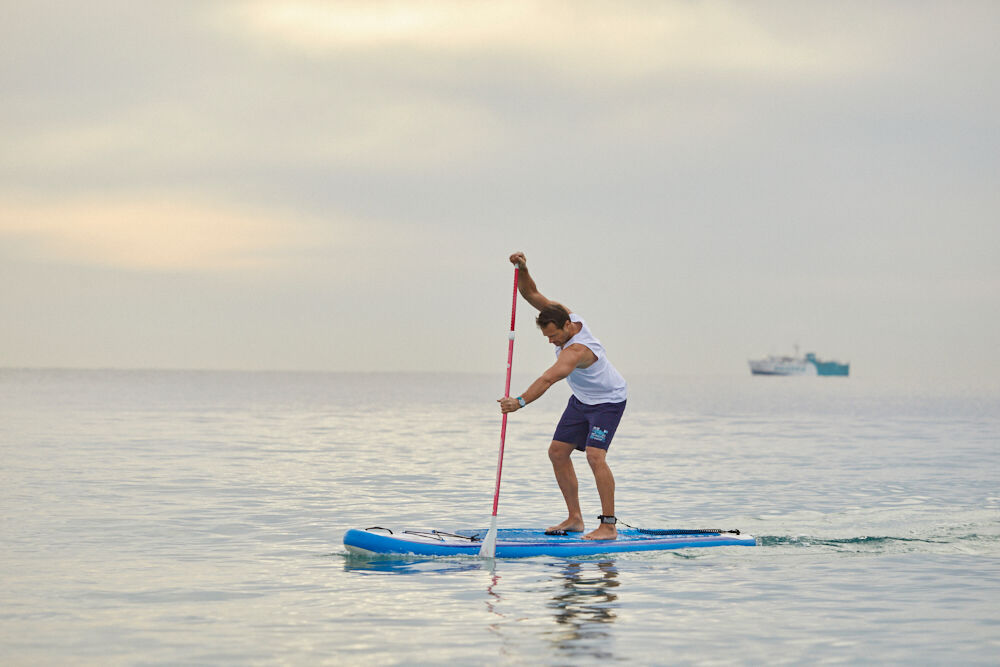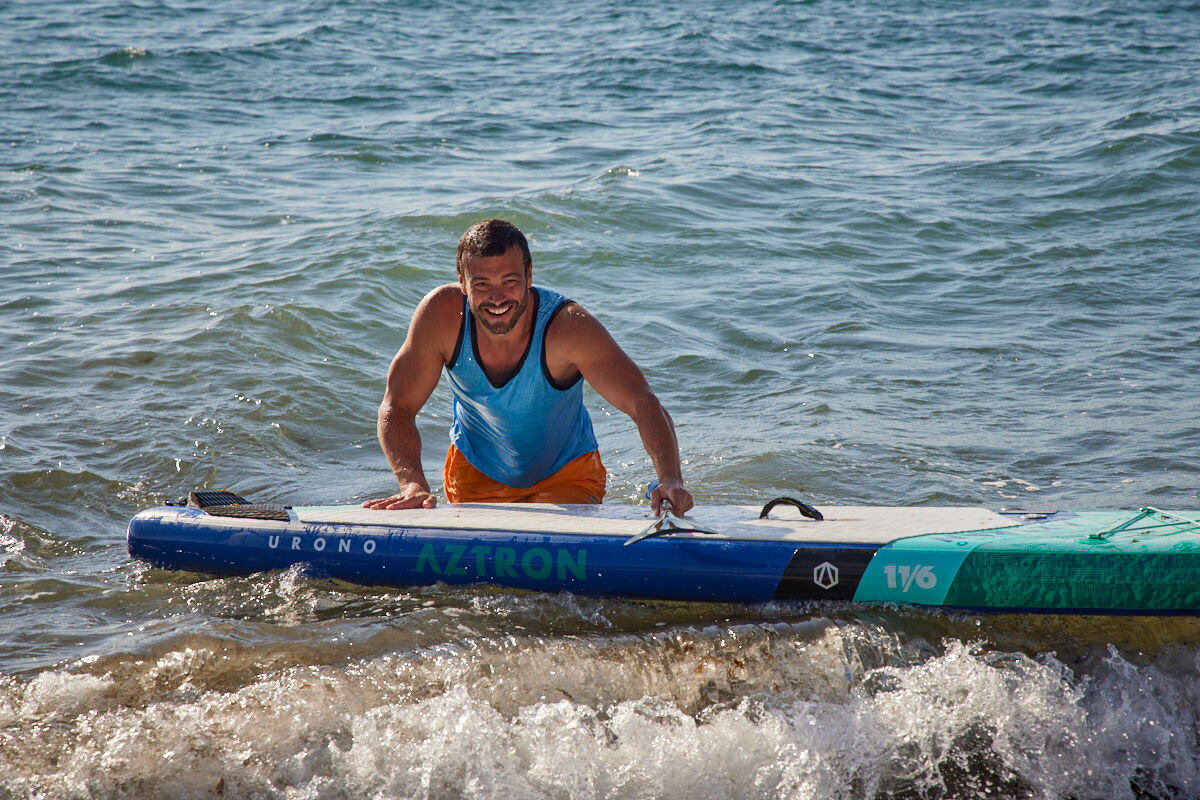
Stand Up Paddle (SUP) Boarding for Beginners
A semi-recent phenomenon, stand up paddle boarding – more simply known as paddle or SUP – is this summer's trendiest water sport! As its name suggests, this alluring aquatic activity is practiced with a board and paddle, letting you experience the deep blue in an alternative manner. Promising no end of holiday, weekend, or early morning fun, it’s a great way to get moving while enjoying a warm, sunny day. So, if the idea of gliding across glimmering waters appeals to you, it’s prime time to get in on the action. From the best choice of equipment to the perfect posture to adopt, we're here to walk you through the paddle boarding process, helping you go from beginner to beach-chic pro in next to no time!
What paddle board is best for beginners: should you opt for an inflatable blow up board or a hard model?
In reality, it's entirely up to you which type of paddle board you choose – no one design is necessarily more beginner friendly than the other. However, since falling off and clambering back onto your board is part of the learning process, it's good to keep in mind that inflatable paddle boards are softer, making them slightly kinder to beginners' bodies, as well as a little less fear inducing... This aside, a couple of practicalities may influence your board buying decisions. If you're short on storage space or want a board that's easy to transport from place to place, then we'd suggest opting for an inflatable paddle board. Easy to roll up (functioning much like a sleeping bag) this type of design can be taken on all adventures. And if you intend on paddle boarding abroad, then this flying-friendly, packable model really can't be trumped! Just be sure to pair it with a collapsible paddle that's equally easy to transport. Inflatable paddle boards are also less susceptible to scuff marks than their solid counterparts and are surprisingly more durable, particularly when put to use in locations where rocks and pebbles are at play. That being said, if you favour performance over practicality, then a hard paddle board is the worthier investment. This type of design promises agility and speed, along with stability – the longer the board the steadier! If, after the initiation stages, you hope to become a skilled paddle boarder, then this second model may well be for you... If you're also planning to fish from your board, practice yoga on it (perhaps even with a pooch aboard) or carry young passengers on it – kids adore being taken for a spin on these things – then a hard design is a sensible choice.


Waves or calm waters for beginner paddleboarders?
Calm waters and wind-free weather make for a far easier ride when first starting out with this sport. Lakes, lochs and reservoirs are the most ideal locations when, metaphorically speaking, dipping your toe in the paddle boarding pool. If a coastal location is your only option for giving paddle boarding a go though, then it's best for newbies to embrace the sea on a still day, when winds are down and there are next to no waves. While wind is somewhat vital to gaining momentum when standing up on your paddle board, calm conditions are far better suited to those early stages when you're still mastering the basics and finding your balance. It's worth noting that should you ever find yourself exposed to a breeze, kneeling on your board is the best technique for maintaining navigational control. Returning to your knees will help you steady yourself too! And if it suddenly starts blowing a gale, then our top tactic is to lay face down on your board with your paddle trapped beneath your body, leaving your hands free to steer your course by performing forward stroke arm movements.
Paddle boarding tips for how to balance: kneel, then stand
It's easiest to mount your board when there is already water beneath its base. Here's a step-by-step guide to finding your balance:
1) Climb onto the middle of your board on your knees, directly adopting a kneeling position
2) Use your paddle to perform a couple of strokes on each side, propelling your board forward
3) Stand up slowly, one foot at a time, being careful to position yourself in the centre of the board
4) Place your feet in a parallel position, keeping them shoulder width apart
5) Keep your knees slightly bent and your weight central
Take note that the easiest way to keep your balance is to fix your eyes on a faraway point on the horizon. It’s also best not to underestimate this water sport's physical demand on your feet and legs. Essentially, if you want to remain stable, you need a steady base, meaning you need to keep your feet still for a long time! If you can keep your balance, then paddle boarding fast becomes a rigorous full body workout – conditioning your calves, ankles and feet, while strengthening your core muscles and upper body too.



Learn to use your paddle properly – good paddling technique is key!
Adopting the correct hand positions is essential to being able to paddle well! In order to hold your paddle properly, place one hand on top of the handle and use the other to grip lower down the shaft of the paddle. If you've got an asymmetric paddle, make sure that the blade is 'open' and facing the same way that you intend to move in – the angle of the blade (technically termed the 'power face') should face behind you, in the opposite direction of travel. So that you can paddle efficiently, ensure the blade is completely submersed, aiming for a spot in the water that's ahead of you. You'll need to bend your body forward a little to achieve this! Then, keep your arms straight and perform a lever-type action. The top arm pushes forward, while the bottom arm pulls backwards. Finally, lift the blade out of the water when it aligns with your feet, and then repeat the process.
Persevere – whenever you fall, get ready to stand back up!
However well you paddle board, falling into the water is sometimes inevitable! Don't be put off therefore if you find yourself consistently making a splash. As time goes on, you will likely fall in less frequently, and be less fazed by contact with the water. However advanced your skills though, to practice this water sport safely, it's vital to always attach the leash of the board to your ankle. Linking you to your board, this leash will enable you to float at any given moment. And if you feel like you're about to fall, then the important thing is to aim for the water rather than your board for a softer landing. The safest method is to try and fall as far away from your board as possible. And there's no need to worry about going under, since the leash will always enable you to quickly return to the surface and reunite with your board.


What to wear paddle boarding?
Thankfully, paddle boarding isn't a sport that demands much (if any) professional gear, especially in summer. When the weather is warm, all you need at your disposal is swimwear or fast drying layers like lightweight microfibre shorts and a polyester jersey vest or t-shirt! While we very much suggest lathering on the sun cream, the latter clothing options will help better protect you from UV rays. If your skill level is more advanced and you're less likely to spend time in the water, then you may even want to consider a baseball cap for enhanced sun protection. Generally speaking, paddle boarding bare foot will help your technique, but beach shoes or wetsuit boots are a good shout dependent on the location, to prevent you from getting any cuts on your feet.
All aboard...
People of all ages and all fitness levels have grown to love paddle boarding in recent years! So, if you've not yet given this water sport a whirl, then let this summer be the one where you experience it for the first time... Fun, relaxed and not overly intensive, this physical activity is great for the body, mind and soul. As well as getting you moving, it lets you get out into nature and leads you beside still waters, offering a real release! So don't hold back – let our beginner's guide initiate you into the world of paddle boarding. And if you're new to watersports full stop, then why not consult our guide to The Top Five Watersports to Try This Summer for yet more maritime fun!